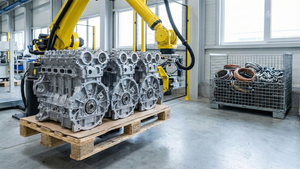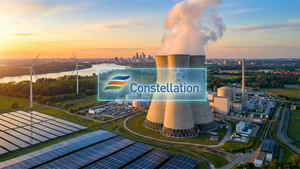
Home energy technology company Enphase (NASDAQ: ENPH) missed Wall Street’s revenue expectations in Q1 CY2025, but sales rose 35.2% year on year to $356.1 million. On the other hand, the company expects next quarter’s revenue to be around $360 million, close to analysts’ estimates. Its non-GAAP profit of $0.68 per share was 6% below analysts’ consensus estimates.
Is now the time to buy ENPH? Find out in our full research report (it’s free).
Enphase (ENPH) Q1 CY2025 Highlights:
- Revenue: $356.1 million vs analyst estimates of $362 million (35.2% year-on-year growth, 1.6% miss)
- Adjusted EPS: $0.68 vs analyst expectations of $0.72 (6% miss)
- Adjusted EBITDA: $76.69 million vs analyst estimates of $115.2 million (21.5% margin, 33.4% miss)
- Revenue Guidance for Q2 CY2025 is $360 million at the midpoint, roughly in line with what analysts were expecting
- Operating Margin: -1.7%, up from -16.3% in the same quarter last year
- Free Cash Flow Margin: 9.5%, down from 15.9% in the same quarter last year
- Sales Volumes rose 10.7% year on year (-71.4% in the same quarter last year)
- Market Capitalization: $6.66 billion
StockStory’s Take
Enphase's first quarter results were shaped by a complex mix of supply chain realignment, shifting demand trends, and product transitions. Management attributed the quarter’s performance to softness in U.S. residential solar demand, operational disruptions among large leasing providers, and elevated channel inventory levels, especially for microinverters. CEO Badri Kothandaraman noted that despite these challenges, Enphase saw progress in scaling its U.S.-based battery and microinverter production, and continued to invest in customer service and software enhancements.
Looking ahead, Enphase’s guidance for the next quarter reflects both near-term headwinds and anticipated benefits from new product introductions. Management was cautious about the impact of newly announced tariffs on Chinese battery components, with plans to absorb most of the cost in the short term while accelerating supply chain diversification. Kothandaraman emphasized the ramp of fourth-generation batteries and the introduction of the IQ9 microinverter as key levers, stating, “We are moving quickly to realign our supply chain to minimize downside across a range of scenarios.”
Key Insights from Management’s Remarks
First quarter performance was influenced by weaker U.S. demand, operational challenges at key customers, and ongoing product launches.
- Tariff Impact and Mitigation: Management highlighted that recently imposed tariffs on batteries sourced from China will reduce gross margin by 2% in the next quarter, with a larger 6% to 8% impact expected by Q3. Enphase plans to absorb most of these costs in the short term and aims to fully offset them by mid-next year by qualifying new suppliers outside China.
- Shift in U.S. Market Demand: U.S. sales were affected by high interest rates and financial difficulties at a major national lease provider, which disrupted installer cash flow and reduced sell-through. Management expects seasonal improvements in Q2 but remains cautious about the overall market environment.
- European Market Developments: While Europe’s business environment remains challenging, Enphase saw growth in regions like Germany, driven by new products such as the FlexPhase battery and IQ EV charger. The company is expanding its portfolio and geographic reach, targeting new markets including Germany, Belgium, and Japan.
- Product Innovation Focus: Enphase is launching a fourth-generation IQ Battery and preparing to introduce the IQ9 microinverter, which uses gallium nitride technology for higher efficiency and is targeted at commercial solar markets. The company is also entering the portable energy storage market with the IQ PowerPack 1500.
- Emphasis on Software and Services: Investment continues in AI-powered energy management software and the Solar Graph installer platform, which management sees as strategic tools to enhance customer value, support grid services, and differentiate the company in both regulated and deregulated markets.
Drivers of Future Performance
Management expects the next quarter to be influenced by tariff-related cost pressures, new product introductions, and ongoing supply chain adjustments, while persistent high interest rates and policy uncertainty remain headwinds.
- Supply Chain Diversification: Enphase’s ability to qualify battery cell suppliers outside China is critical for restoring gross margins by mid-next year. Management believes mitigation efforts will gradually reduce tariff impact over the next three quarters.
- New Product Ramps: The rollout of the fourth-generation IQ Battery and the upcoming IQ9 microinverter are expected to drive growth, particularly as cost reductions and improved installation features make backup systems more accessible.
- Policy and Market Uncertainty: Management cited unresolved U.S. policy questions, such as IRA (Inflation Reduction Act) clarity and high interest rates, as factors potentially delaying demand recovery and installer investment. The company remains focused on innovation and customer support to manage through this period.
Top Analyst Questions
- Praneeth Satish (Wells Fargo): Asked about Enphase’s plan to absorb most of the tariff impact rather than passing it to customers. Management explained this is a temporary measure, with full mitigation expected once new suppliers are qualified.
- Phil Shen (ROTH Capital Partners): Inquired about the revenue trajectory for the remainder of the year and whether new product launches could offset market headwinds. Enphase pointed to the fourth-generation battery and IQ9 microinverter as key drivers, though stopped short of providing quarterly guidance.
- Brian Lee (Goldman Sachs): Questioned the outlook for battery shipment volumes and margin recovery given tariff impacts. Management expects sequential improvement as new supply sources are brought online and system costs decline through integration.
- Mark Strouse (JPMorgan): Sought clarification on whether changes in battery cell sourcing would require redesign or recertification. Management stated that existing LFP chemistry will be maintained, with standard qualification processes for new suppliers.
- Colin Rusch (Oppenheimer): Asked about logistics and shipping risks amid global disruptions. Management highlighted that most microinverters are already U.S.-made and battery production in Texas is increasing, reducing exposure to overseas shipping issues.
Catalysts in Upcoming Quarters
In the coming quarters, the StockStory team will be monitoring (1) evidence of successful supply chain diversification away from China for battery cells and other key components, (2) the market adoption and cost impact of the fourth-generation IQ Battery and IQ9 microinverter, and (3) trends in installer demand as U.S. interest rates and IRA policy clarity evolve. Progress in expanding into new international markets and product verticals will also be closely watched.
Enphase currently trades at a forward P/E ratio of 15.2×. Is the company at an inflection point that warrants a buy or sell? The answer lies in our free research report.
Our Favorite Stocks Right Now
The market surged in 2024 and reached record highs after Donald Trump’s presidential victory in November, but questions about new economic policies are adding much uncertainty for 2025.
While the crowd speculates what might happen next, we’re homing in on the companies that can succeed regardless of the political or macroeconomic environment. Put yourself in the driver’s seat and build a durable portfolio by checking out our Top 6 Stocks for this week. This is a curated list of our High Quality stocks that have generated a market-beating return of 176% over the last five years.
Stocks that made our list in 2020 include now familiar names such as Nvidia (+1,545% between March 2020 and March 2025) as well as under-the-radar businesses like the once-micro-cap company Kadant (+351% five-year return). Find your next big winner with StockStory today.






